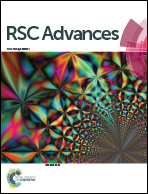Magnetoliposomes based on manganese ferrite nanoparticles as nanocarriers for antitumor drugs†
Abstract
Manganese ferrite nanoparticles with a size distribution of 26 ± 7 nm (from TEM measurements) were synthesized by the coprecipitation method. The obtained nanoparticles exhibit a superparamagnetic behaviour at room temperature with a magnetic squareness of 0.016 and a coercivity field of 6.3 Oe. These nanoparticles were either entrapped in liposomes (aqueous magnetoliposomes, AMLs) or covered with a lipid bilayer, forming solid magnetoliposomes (SMLs). Both types of magnetoliposomes, exhibiting sizes below or around 150 nm, were found to be suitable for biomedical applications. Membrane fusion between magnetoliposomes (both AMLS and SMLs) and GUVs (giant unilamellar vesicles), the latter used as models of cell membranes, was confirmed by Förster Resonance Energy Transfer (FRET) assays, using a NBD labeled lipid as the energy donor and Nile Red or rhodamine B-DOPE as the energy acceptor. A potential antitumor thienopyridine derivative was successfully incorporated into both aqueous and solid magnetoliposomes, pointing to a promising application of these systems in oncological therapy, simultaneously as hyperthermia agents and nanocarriers for antitumor drugs.



 Please wait while we load your content...
Please wait while we load your content...